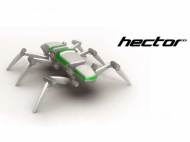Insect biomimicry inspires HECTOR – robot hexapod
 A team of biologists and engineers at the Bielefeld University Center of Excellence Cognitive Interaction Technology (CITEC) are developing the Hexapod Cognitive Autonomously Operating Robot (HECTOR) – a walking robot inspired by six-legged insects. Technologically, HECTOR implements the properties of its biological models better than ever before. When completed, HECTOR will be used as a versatile test bed in various departments and projects.
A team of biologists and engineers at the Bielefeld University Center of Excellence Cognitive Interaction Technology (CITEC) are developing the Hexapod Cognitive Autonomously Operating Robot (HECTOR) – a walking robot inspired by six-legged insects. Technologically, HECTOR implements the properties of its biological models better than ever before. When completed, HECTOR will be used as a versatile test bed in various departments and projects.
Like an insect, the robot possesses an extremely light and strong exoskeleton. The thin-walled body shell made of carbon-fiber reinforced plastic was developed and optimized in cooperation with the Leibniz Institute of Polymer Research Dresden. Even with a 30-kilogram (66-pound) load, the deformation is less than 1 mm (roughly 25th part of an inch). Its three-segment body shell makes up only approximately 13% of the total weight of 12 kg (26.5 pounds), and it is 1 meter long (a bit over 3 feet).
Led by project managers, Dr. Axel Schneider (Faculty of Technology) and Prof. Dr. Josef Schmitz (Faculty of Biology), who contributed with the many years of research experience with the hexapod walking robot TARRY, the leading developers of HECTOR are from the Mechatronics of Biomimetic Actuators and the Department of Biological Cybernetics. The former contributed their extensive know-how in the field of biologically inspired drives and drive controls with the physicist Jan Paskarbeit being decisively responsible for the mechatronic work.
New joint drives have been developed for HECTOR, and each of these highly integrated drives is equipped with all the necessary sensors, the complete control electronics with its own processor as well as elastic coupling with sensors for which a patent has been applied. This makes it possible to control each of the 18 leg joints on the basis of biologically inspired control algorithms and, for example, react by yielding during collisions or interactions with human beings.
In order to facilitate changing the special sensor equipment for different studies, the body design follows an exchangeable lid concept developed in cooperation with the Folkwang Hochschule in Essen. This enables the robot to switch quickly from an omnidirectional camera for near-range and its tactile antenna for long range in order to explore its proximal space. A special interface and bus concept has also been developed, making it easy to link the sensory information processing with the movement control system.
The robot’s control program works according to the distributed intelligence principle found in insect brains, and its developers plan to make it able to learn and plan ahead. In future, this will enable HECTOR to make its way through unfamiliar territory and, for example, autonomously carry out exploration tasks.









Seems interesting, but far from realization.
I would suggest development of alternative movement algorithms in case one of the legs suffers a malfunction.